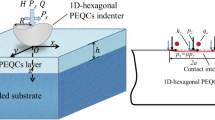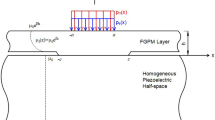Abstract
The present article establishes a partial contact model to reveal how the contact strength of two piezoelectric materials is influenced by the wavy surface topography. General solutions of governing equations of the piezoelectric materials are presented. Dual series equations are obtained and solved by considering the Werner formulas and Mehler integral. For evaluating various stresses and electric displacements, the related explicit expressions are presented. Numerical tests are conducted to examine in what way the external loading and the piezoelectric coefficient ratio affect the contact performances between two piezoelectric materials. Results delineate that the external loading has a bigger contribution on forming the contact region between two different piezoelectric materials compared with the piezoelectric coefficient ratio.









Similar content being viewed by others
References
Hills, D.A., Nowell, D., Sackfield, A.: Mechanics of Elastic Contacts. Butterworth-Heinemann, Oxford (1993)
Barber, J.R., Ciavarella, M.: Contact mechanics. Int. J. Solids Struct. 37, 29–43 (2000)
Gladwell, G.M.L.: Contact Problems in the Classical Theory of Elasticity. Sijthoff and Noordhof, The Netherlands (1980)
Johnson, K.L.: Contact Mechanics. Cambridge University Press, Cambridge (1985)
Tichy, J.A., Meyer, D.M.: Review of solid mechanics in tribology. Int. J. Solids Struct. 37, 391–400 (2000)
Yastrebov, V.A., Anciaux, G., Molinari, J.F.: Contact between representative rough surfaces. Phys. Rev. E 86, 035601(R) (2012)
Greenwood, J.A., Williamson, J.B.P.: Contact of nominally flat surfaces. Proc. R. Soc. A 295, 300–319 (1966)
Thomas, T.R.: Rough Surfaces, 2nd edn. Imperial College Press, Cambridge (1999)
Greenwood, J.A.: A simplified elliptic model of rough surface contact. Wear 261, 191–200 (2006)
Carbone, G., Bottiglione, F.: Asperity contact theories: do they predict linearity between contact area and load? J. Mech. Phys. Solids 56, 2555–2572 (2008)
Paggi, M., Ciavarella, M.: The coefficient of proportionality k between real contact area and load, with new asperity models. Wear 268, 1020–1029 (2010)
Dundurs, J., Tsai, K.C., Keer, L.M.: Contact between elastic bodies with wavy surfaces. J. Elast. 3, 109–115 (1973)
Jin, C.R., Khare, K., Vajpayee, S., Yang, S., Jagota, A., Hui, C.Y.: Adhesive contact between a rippled elastic surface and a rigid spherical indenter: from partial to full contact. Soft Matter 7, 10728–10736 (2011)
Jin, F., Guo, X.: Mechanics of axisymmetric adhesive contact of rough surfaces involving power-law graded materials. Int. J. Solids Struct. 50, 3375–3386 (2013)
Yao, Y., Chen, S.H.: The effects of fiber’s surface roughness on the mechanical properties of fiber-reinforced polymer composites. J. Compos. Mater. 0(0), 1–15 (2015)
Lezgy-Nazargah, M., Vidal, P., Polit, O.: An efficient finite element model for static and dynamic analyses of functionally graded piezoelectric beams. Compos. Struct. 104, 71–84 (2013)
Fan, H., Sze, K.Y., Yang, W.: Two-dimensional contact on a piezoelectric half-space. Int. J. Solids Struct. 33, 1305–1315 (1996)
Hao, T.H.: Exact solution of a flat smooth punch on a piezoelectric half plane. Mech. Res. Commun. 30, 455–461 (2003)
Wang, B.L., Han, J.C.: A circular indenter on a piezoelectric layer. Arch. Appl. Mech. 76, 367–379 (2006)
Zhou, Y.T., Lee, K.Y.: Theory of moving contact of anisotropic piezoelectric materials via real fundamental solutions approach. Eur. J. Mech. A. Solids 35, 22–36 (2012)
Zhou, Y.T., Zhong, Z.: Frictional indentation of anisotropic magneto-electro-elastic materials by a rigid indenter. J. Appl. Mech. Trans. ASME 81, 071001 (2014)
Ma, J., Ke, L.L., Wang, Y.S.: Electro-mechanical sliding frictional contact of a piezoelectric half-plane under a rigid conducting punch. Appl. Math. Model. 38, 5471–5489 (2014)
Wang, B.L., Han, J.C., Du, S.Y., Zhang, H.Y., Sun, Y.G.: Electromechanical behavior of a finite piezoelectric layer under a flat punch. Int. J. Solids Struct. 45, 6384–6398 (2008)
Guo, X., Jin, F.: A generalized JKR-model for two-dimensional adhesive contact of transversely isotropic piezoelectric half-space. Int. J. Solids Struct. 46, 3607–3619 (2009)
Ke, L.L., Yang, J., Kitipornchai, S., Wang, Y.S.: Frictionless contact analysis of a functionally graded piezoelectric layered half-plane. Smart Mater. Struct. 17, 025003 (2008)
Ke, L.L., Yang, J., Kitipornchai, S., Wang, Y.S.: Electro-mechanical frictionless contact behavior of a functionally graded piezoelectric layered half-plane under a rigid punch. Int. J. Solids Struct. 45, 3313–3333 (2008)
Ke, L.L., Wang, Y.S., Yang, J., Kitipornchai, S.: Sliding frictional contact analysis of functionally graded piezoelectric layered half-plane. Acta Mech. 209, 249–268 (2010)
Maceri, F., Bisegna, P.: The unilateral frictionless contact of a piezoelectric body with a rigid support. Math. Comput. Model. 28, 19–28 (1998)
Bisegna, P., Lebon, F., Maceri, F.: The unilateral frictional contact of a piezoelectric body with a rigid support. In: Martins, J.A.C., Monteiro Marques, M.D.P. (eds.) Contact Mechanics, pp. 347–354. Kluwer, Dordrecht (2002)
Barboteu, M., Fernández, J.R., Tarraf, R.: Numerical analysis of a dynamic piezoelectric contact problem arising in viscoelasticity. Comput. Methods Appl. Mech. Eng. 197, 3724–3732 (2008)
Migórski, S., Ochal, A., Sofonea, M.: Analysis of a quasistatic contact problem for piezoelectric materials. J. Math. Anal. Appl. 382, 701–713 (2011)
Barboteu, M., Sofonea, M.: Modelling of piezoelectric contact problems. In: Stavroulakis, G.E. (ed.) Recent Advances in Contact Mechanics. Springer, Berlin (2013)
Sofonea, M., Kazmi, K., Barboteu, M., Han, W.M.: Analysis and numerical solution of a piezoelectric frictional contact problem. Appl. Math. Model. 36, 4483–4501 (2012)
Migórski, S., Ochal, A., Sofonea, M.: History-dependent subdifferential inclusions and hemivariational inequalities in contact mechanics. Nonlinear Anal. 12, 3384–3396 (2011)
Sofonea, M., Matei, A.: History-dependent quasivariational inequalities arising in contact mechanics. Eur. J. Appl. Math. 22, 471–491 (2011)
Migórski, S., Ochal, A., Sofonea, M.: Analysis of a piezoelectric contact problem with subdifferential boundary condition. Proc. R. Soc. Edinb. 144A, 1007–1025 (2014)
Zhou, Y.T., Zhong, Z.: Application of dual series equations approach to wavy contact between piezoelectric materials and an elastic solid. Int. J. Appl. Mech. 6, 1450046 (2014)
Suzuki, Y., Kagawa, Y.: Vibration control and sinusoidal external force estimation of a flexible shaft using piezoelectric actuators. Smart Mater. Struct. 21, 125006 (2012)
Tolliver, L., Xu, T.B., Jiang, X.N.: Finite element analysis of the piezoelectric stacked-HYBATS transducer. Smart Mater. Struct. 22, 035015 (2013)
Kulikov, G.M., Plotnikova, S.V.: Exact electroelastic analysis of functionally graded piezoelectric shells. Int. J. Solids Struct. 51, 13–25 (2014)
Li, Y.D., Lee, K.Y.: Effects of finite dimension on the electro-elastic responses of an interface electrode in a piezoelectric actuator. ZAMM 90, 42–52 (2010)
Ramirez, G., Heyliger, P.: Frictionless contact in a layered piezoelectric half-space. Smart Mater. Struct. 12, 612–625 (2003)
Ramirez, G.: Frictionless contact in a layered piezoelectric media characterized by complex eigenvalues. Smart Mater. Struct. 15, 1287–1295 (2006)
Loboda, V., Sheveleva, A., Lapusta, Y.: An electrically conducting interface crack with a contact zone in a piezoelectric bimaterial. Int. J. Solids Struct. 51, 63–73 (2014)
Sneddon, I.N.: Mixed Boundary Value Problems in Potential Theory. North-Holland, Amsterdam (1966)
Acknowledgments
Supports from the National Natural Science Foundation of China (11472193, 11090334 and 11261045), Shanghai Pujiang Program (14PJ1409100) and the Fundamental Research Funds for the Central Universities (1330219140) are gratefully acknowledged.
Author information
Authors and Affiliations
Corresponding author
Appendix
Appendix
-
1.
Expressions of the elements of symmetrical matrix \(\mathbf{A}_j =(a_{nk}^{(j)} )_{3\times 3} (j=1,2)\) appearing in Eq. (5)
$$\begin{aligned} a_{11}^{(j)}= & {} C_{11}^{(j)} \frac{\partial ^{2}}{\partial x^{2}}+C_{44}^{(j)} \frac{\partial ^{2}}{\partial z^{2}},\qquad a_{12}^{(j)} =\left( {C_{13}^{(j)} +C_{44}^{(j)} } \right) \frac{\partial ^{2}}{\partial x\partial z},\nonumber \\ a_{13}^{(j)}= & {} \left( {e_{15}^{(j)} +e_{31}^{(j)} } \right) \frac{\partial ^{2}}{\partial x\partial z}, \qquad a_{22}^{(j)} =C_{44}^{(j)} \frac{\partial ^{2}}{\partial x^{2}}+C_{33}^{(j)} \frac{\partial ^{2}}{\partial z^{2}}, \nonumber \\ a_{23}^{(j)}= & {} e_{15}^{(j)} \frac{\partial ^{2}}{\partial x^{2}}+e_{33}^{(j)} \frac{\partial ^{2}}{\partial z^{2}},\qquad a_{33}^{(j)} =-\in _{11}^{(j)} \frac{\partial ^{2}}{\partial x^{2}}-\in _{33}^{(j)} \frac{\partial ^{2}}{\partial z^{2}}. \end{aligned}$$(76) -
2.
Expressions of \(c_k^{(j)} (j=1,2,k=0,1,2,3)\) appearing in Eq. (6)
$$\begin{aligned} c_0^{(j)}= & {} -C_{44}^{(j)} \left[ {\left( {e_{33}^{(j)} } \right) ^{2}+C_{33}^{(j)} \in _{33}^{(j)} } \right] ,\nonumber \\ c_1^{(j)}= & {} -C_{33}^{(j)} \left[ {C_{44}^{(j)} \in _{11}^{(j)} +\left( {e_{15}^{(j)} +e_{31}^{(j)} } \right) ^{2}} \right] -\in _{33}^{(j)} \left[ {C_{11}^{(j)} C_{33}^{(j)} +\left( {C_{44}^{(j)} } \right) ^{2}} \right. \nonumber \\&-\left. {\left( {C_{13}^{(j)} +C_{44}^{(j)} } \right) } \right] -e_{33}^{(j)} \left[ {2C_{44}^{(j)} e_{15}^{(j)} +C_{11}^{(j)} e_{33}^{(j)} -2\left( {C_{13}^{(j)} +C_{44}^{(j)} } \right) \left( {e_{15}^{(j)} +e_{31}^{(j)} } \right) } \right] , \nonumber \\ c_2^{(j)}= & {} -C_{44}^{(j)} \left[ {C_{11}^{(j)} \in _{33}^{(j)} +\left( {e_{15}^{(j)} +e_{31}^{(j)} } \right) ^{2}} \right] -\in _{11}^{(j)} \left[ {C_{11}^{(j)} C_{33}^{(j)} +\left( {C_{44}^{(j)} } \right) ^{2}} \right. \nonumber \\&-\left. {\left( {C_{13}^{(j)} +C_{44}^{(j)} } \right) } \right] -e_{15}^{(j)} \left[ {2C_{11}^{(j)} e_{33}^{(j)} +C_{44}^{(j)} e_{15}^{(j)} -2\left( {C_{13}^{(j)} +C_{44}^{(j)} } \right) \left( {e_{15}^{(j)} +e_{31}^{(j)} } \right) } \right] , \nonumber \\ c_3^{(j)}= & {} -C_{11}^{(j)} \left[ {\left( {e_{15}^{(j)} } \right) ^{2}+C_{44}^{(j)} \in _{11}^{(j)} } \right] . \end{aligned}$$(77) -
3.
Expressions of \(\alpha _{mn}^{(j)} (j=1,2,m,n=1,2,3)\) appearing in Eq. (7)
$$\begin{aligned} \alpha _{11}^{(j)}= & {} \left( {C_{13}^{(j)} +C_{44}^{(j)} } \right) \in _{11}^{(j)} +\left( {e_{15}^{(j)} +e_{31}^{(j)} } \right) e_{15}^{(j)}, \nonumber \\ \alpha _{12}^{(j)}= & {} \left( {C_{13}^{(j)} +C_{44}^{(j)} } \right) \in _{33}^{(j)} +\left( {e_{15}^{(j)} +e_{31}^{(j)} } \right) e_{33}^{(j)}, \end{aligned}$$(78)$$\begin{aligned} \alpha _{21}^{(j)}= & {} -C_{11}^{(j)} \in _{11}^{(j)}, \nonumber \\ \alpha _{22}^{(j)}= & {} -C_{11}^{(j)} \in _{33}^{(j)} -\left( {e_{15}^{(j)} +e_{31}^{(j)} } \right) ^{2}-C_{44}^{(j)} \in _{11}^{(j)}, \nonumber \\ \alpha _{23}^{(j)}= & {} -C_{44}^{(j)} \in _{33}^{(j)}, \end{aligned}$$(79)$$\begin{aligned} \alpha _{31}^{(j)}= & {} -C_{11}^{(j)} e_{15}^{(j)}, \nonumber \\ \alpha _{32}^{(j)}= & {} -C_{11}^{(j)} e_{33}^{(j)} +C_{13}^{(j)} \left( {e_{15}^{(j)} +e_{31}^{(j)} } \right) ^{2}+C_{44}^{(j)} e_{31}^{(j)}, \nonumber \\ \alpha _{33}^{(j)}= & {} -C_{44}^{(j)} e_{33}^{(j)}. \end{aligned}$$(80) -
4.
Expressions of \(\eta _{k,xx}^{(j)}, \, \eta _{k,zz}^{(j)},\,\eta _{k,xz}^{(j)},\,\eta _{k,dx}^{(j)} \) and \(\eta _{k,dz}^{(j)}\left( {j=1,2,k=1,2,3} \right) \) appearing in Eqs. (36)–(40)
$$\begin{aligned} \eta _{k,xx}^{(j)}= & {} -C_{11} +C_{13} \beta _{k1}^{(j)} \gamma _k^{(j)} +e_{31} \beta _{k2}^{(j)} \gamma _k^{(j)} \qquad (j=1,2), \end{aligned}$$(81)$$\begin{aligned} \eta _{k,zz}^{(j)}= & {} -C_{13} +C_{33} \beta _{k1}^{(j)} \gamma _k^{(j)} +e_{33} \beta _{k2}^{(j)} \gamma _k^{(j)} \qquad (j=1,2), \end{aligned}$$(82)$$\begin{aligned} \eta _{k,xz}^{(j)}= & {} -\left( {C_{44} \gamma _k^{(j)} +C_{44} \beta _{k1}^{(j)} +e_{15} \beta _{k2}^{(j)} } \right) \qquad (j=1,2), \end{aligned}$$(83)$$\begin{aligned} \eta _{k,dx}^{(j)}= & {} -\left( {e_{15} \gamma _k^{(j)} +e_{15} \beta _{k1}^{(j)} -\in _{11} \beta _{k2}^{(j)} } \right) \qquad (j=1,2), \end{aligned}$$(84)$$\begin{aligned} \eta _{k,dz}^{(j)}= & {} -e_{31} +e_{33} \beta _{k1}^{(j)} \gamma _k^{(j)} -\in _{33} \beta _{k2}^{(j)} \gamma _k^{(j)} \qquad (j=1,2). \end{aligned}$$(85) -
5.
Expressions of the elements of matrices \(\mathbf{D}_j =(d_{nk}^{(j)} )_{3\times 3} (j=1,2)\) appearing in Eq. (41)
$$\begin{aligned} d_{1k}^{(j)} =1, d_{2k}^{(j)} =\eta _{k,zz}^{(j)}, d_{3k}^{(j)} =\eta _{k,dz}^{(j)} \quad \left( {j=1,2,k=1,2,3} \right) . \end{aligned}$$(86)
Rights and permissions
About this article
Cite this article
Zhou, YT., Zhong, Z. Partial contact in two-layered piezoelectric structure with interface occupying periodic profiles. Arch Appl Mech 85, 1649–1665 (2015). https://doi.org/10.1007/s00419-015-1010-y
Received:
Accepted:
Published:
Issue Date:
DOI: https://doi.org/10.1007/s00419-015-1010-y




